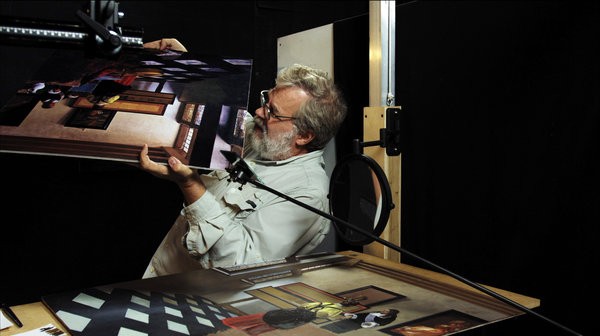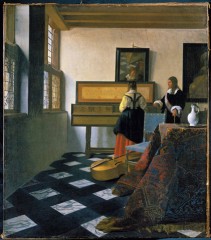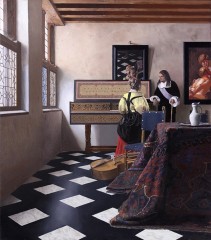 TIM JENISON IN TIM'S VERMEERDid Vermeer paint by the numbers?
TIM JENISON IN TIM'S VERMEERDid Vermeer paint by the numbers?Tim Jenison is an inventor living in San Antonio, Texas, owner of the NewTek software company (founded in 1985) and marketer of several successful products having to do with video and computer imaging. He therefore had the money and the time and the technical knowhow to carry out, in recent years, a demanding experiment exploring how the great Dutch 17th-century painter Johannes Vermeer might have used optical devices to make his paintings. As Jenison puts it, he decides "to paint a Vermeer" -- specifically, his
The Music Lesson, which resides at Buckingham Palace. Jenison's friend the magician Teller of Penn and Teller made a film of his years-long effort. It's intriguing -- until it becomes tedious, once it gets into documenting the actual painstaking process of making the painting, some four months of meticulous, mind-numbing work. Then finally it's depressing. This is because, while showing the connection of art and technology, art and invention, art and science, it loses touch with what art is, how technology, invention, or science do not explain it and are essentially different from it.
Various people have theorized that other great painters of the past (Caravaggio is mentioned in the film) used lenses and the camera obscura in doing their work. Perhaps an inspiration for Jension is that in the same year, 2001, Philip Steadman, a professor at University College, London, published a book called
Vermeer's Camera: Uncovering the Truth behind the Masterpieces, and the English painter David Hockney published the widely publicized
Secret Knowledge: Rediscovering the Lost Techniques of the Old Masters. Both books argue that Vermeer used such methods. And both men are heard from and met with in the film. They are pleased with this project, which supports their theories.
Motives for attributing such techniques to Vermeer, in particular, seem to come from a certain "photographic" quality in his paintings (though to say that is to distort their complexity); from the way Vermeer captures light; and from the fact that X-rays show no preliminary drawing underneath. This suggests, to some anyway, that Vermeer simply worked directly from images cast on the canvas using optical devices. There is no evidence of this, no record of Vermeer's using such methods. Jenison, naively I think, believes the fact that there is no record of Vermeer's undergoing training or apprenticeship as a painter is further evidence that he just painted "by the numbers." There just isn't much information about Vermeer. That we don't know of Vermeer's training doesn't prove he had none. Nor does using optical devices mean an artist would need no prior study of painting, or be able to paint like Vermeer, create his images, ring his special changes on Dutch genre painting, create the magic of his poses, his portraits, his uses of color and light. As another reviewer of this film points out, how do we know he simply copied the colors of the rugs or cloths he painted, or of a woman's hair? But none of this is considered by Jenison, who is concerned with copying the mockup he has created in his warehouse.
There is after all something a little bit circular about Jenison's explorations. He sets up a Vermeer painstakingly from scratch in great detail and then paints it, with a reproduction of the Vermeer sometimes at hand. Is it a surprise that the result looks like the Vermeer? It's a copy of a Vermeer, done in a particularly complicated way. So what?
Jenison's first original discovery -- or invention anyway, certainly a clever one, is that a small mirror on a stick, moved back and forth in front of the area one is painting, can be used to "copy" directly from a projected camera obscura image. (A camera obscura, a predecessor of the camera, is a sort of box-like pinhole camera, which projects the image of a room onto a wall, upside down; the image becomes brighter and clearer when a lens is added.) Jenison first paints a creditable copy of a black and white photo of his father-in-law as a young man, using such a mirror, with no previous painting experience. His second discovery is that one can simply use a lens, without the darkness of a camera obscura, so one can see the colors and the light and reflect them with the mirror directly. These I take it are ideas not worked out by theorizers previously about 17th-century painters using optical devices to paint from life by projection.
Perhaps Vermeer
might have painted this way. We still don't know that he did. But again, whether he did or not, Jenison's project provides little insight into Vermeer's art, and offers almost no discussion of his style. In fact some of the things Teller and Jenison say about Vermeer's painting are borderline moronic.
At the end, when he has finished the painting, Jenison says very quickly that all credit for it is due to Vermeer's composition and his genius. But this seems a hasty afterthought. Jenison either does not see or fails to make sufficiently clear that what makes Vermeer Vermeer is something other than the optical devices, which he may very well have used (though it's not known if he did).
After watching Jenison go through the motions of painting a Vermeer we learn what may be one reason why there are few Vermeers: because they took a hell of a lot of time and work to do. Vermeer clearly was an artist of enormous patience. But he doubtless enjoyed the work more and understood it better than Jenison does.
After the lengthy process of setting up the room in a small warehouse, learning to grind his own paint, making handmade glass for the windows, hand crafting the chair and the virginal and stenciling the design on the virginal he builds (or the frame of it), finding a viola da gamba and a suitable rug, crafting the tile floor, the actual painting process takes about four months of continuous back-breaking work, particularly exhausting when it comes to the design on the virginal and (most of all) the draped rug, which can be seen in the original painting and in the lensed projection of the mockup in such detail that every fiber stands out, and so every fiber must be painted. Jenison says he would quit if it weren't a film, and when he is done, he weeps for joy and exhaustion. And well he might. He's carried out an exhausting project.
In the film Jenison, a jovial, bearded fellow with a rich clear speaking voice who does most of the narration himself (with a bit from Teller), gets to meet in England with Hockney and Steadman; earlier Steadman comes to see him after his first mirror-painting. He also gets to look at the actual painting for half an hour, though at first the Queen doesn't want to allow him. It's darker and bluer than the reproductions, he says, and as one must always say, the reproductions can't do it justice.
Neither can this project, or the film about it, which make it look like somehow Vermeer painted by the numbers. But for fans of Vermeer and the history of painting, it's something one must be aware of. And don't get me wrong: I am impressed by what Jenison has done. As hobbyists go, he is an exceptionally creative and diligent one.
Tim's Vermeer, 80 mins., debuted at Toronto Sept. 2013; also a sidebar item at the New York Film Festival. Limited US release began 6 Dec. 2013. Screened for this review at City Cinemas Village East Cinema, 2nd Ave., NYC, 16 Mar. 2014 (formerly at Angelika Film Center).

 VERMEER'S 'MUSIC LESSON'; JENISON'S PAINTING
VERMEER'S 'MUSIC LESSON'; JENISON'S PAINTING




